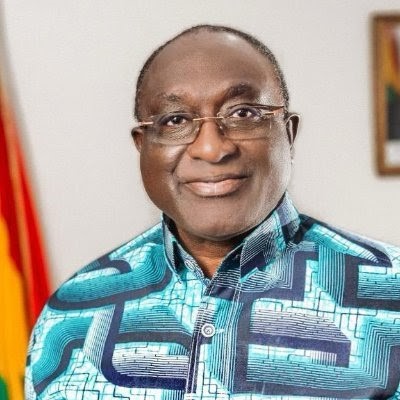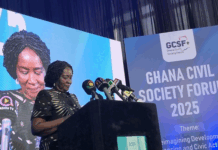On Monday, June 24, 2024, independent presidential aspirant in Ghana’s 2024 general elections and leader of the Movement for Change, Alan John Kwadwo Kyerematen transformed one of the auditoria at the Movenpick Ambassador Hotel in Accra into a pitching deck where he officially presented his Great Transformational Plan (GTP) to the nation and the world at large.
Launching the GTP officially
Impressively, I was able to watch this live online on one of the teaming FM cum TV channels in Ghana on my tablet in the comfort of my abode somewhere outside the boundaries of the country. I had a friend on a telephone connection who was also watching the event live from his location in the United Kingdom. We occasionally interrupted the watching with commentaries.
After collaborative messages from some political cohorts, when it got to his turn, I saw in the aspirant, Alan Kyerematen, a man with a deep-seated conviction confidently determined to drum home a vision he probably was thinking his audience, Ghanaians, were finding difficult to grasp.
Reminiscent of some business pitches, his was like an entrepreneur with an absolute believe in his business plan and projections, trying so hard to make potential investors believe in his venture and go with him. That’s how it was perceived…
… and just as I was about to utter a word on what I was thinking to my friend watching from the UK, he shouted into the speaker of the phone pinned to my left ear; “HE GO EXPLAIN TIRE!” “Benito, don’t you think the man dey talk too much?” My friend sobered his voice this time. He continued, “he’s got a point though but I feel say he dey tire too much to explain am.” I whispered to him on the phone: “CONVICTION. That’s what it is called. He believes too much in his course. People should hear him out.”
Then suddenly I remembered the other political John. Mahama and his 24-hour gang, explaining their sunset economy Gidigidi Gidigidi. I remembered also the political Mate, Bawumia and his stage dancing and his demand for the “Steer” – Gidigidi, Gidigidi, Gidigidi. Ah, remembrance galore! The political cheese, Cheddar, the only Asante seaman, and his over-ambitious rhetoric of taking the sea to Kumasi was also remembered. I also remembered some political opportunists and charlatans and their efforts to throw dusts.
…. and I said to my friend that before the 24-hour economy buzz, before the pomposity of “dredging” the sea to Kumasi and the numerous other political messaging and razzmatazz, the independent ‘holy grail’, the Great Transformational Plan, the GTP sound-bite had been offered; officially launching was to further stress on its necessity.
“I agree with you, Benito, but I again stress that the man go EXPLAIN TAYA”, my friend contended during our discourse on Alan’s GTP after the launch event had long ended in Ghana.
“We could draw some parallels with Alan’s GTP and its message should be understood in just one sentence”, I said to my friend.
However, before we attempt to stimulate any one-liner understanding of Alan’s Great Transformational Plan, let’s try to understand Alan’s pitch.
The great transformational plan explained
On the pitching deck, Alan, just like other contenders are doing, is also proffering an alternative comprehensive strategy aimed at revolutionizing Ghana’s socio-economic landscape. It aspires to address structural weaknesses, foster economic growth, and position Ghana as a competitive player in the global market. He calls this the Great Transformational Plan (…and the guy-name is GTP). He believes this GTP guy will significantly deal with poverty, and bring prosperity to all Ghanaians.
And as if he is holding the bull by the horn, he strategizes to begin with by downsizing Government. Period! He promises to overhaul the architecture of the public service in the country by consolidating some existing Ministries, Departments, and Agencies.
Aside this, Mr. Kyerematen says his GTP would also rest on some other sound pillars namely; Building of a strong macroeconomic environment; Introducing a new agricultural revolution (NAR) for Ghana; Promoting industrial transformation; Accelerating infrastructure development; Digital mainstreaming; and the provision of energy security and diversification.
Others include the: expansion of health infrastructure and services; undertaking a comprehensive review of existing reforms in the educational sector, particularly the Free SHS programme; leveraging the tourism potential in each district and region of Ghana and developing and implementing a comprehensive programme for the management of Ghana’s natural resources.
He also plans to scale up government’s current efforts at reducing Ghana’s carbon footprints and facilitating access to the carbon trading markets, as well as establishing mechanisms to strengthen the country’s preparedness against the negative effects of climate change and climate variability; and deploy resources to strengthen national security and defence mechanisms and infrastructure.
The rest would include a strategic engagement with the international community, and investment in sports.
Potential impacts of GTP
Gleaming with pride and projected self-actualization, Alan believes some of the potential impacts of his GTP would be the following:
Economic Growth: The GTP’s focus on industrialization and export diversification is expected to spur economic growth by creating jobs, increasing incomes, and reducing poverty. By processing raw materials locally, the country can retain more value and enhance its trade balance.
Job Creation and Poverty Reduction: Agro-processing and other industrial activities are labor-intensive, promising significant employment opportunities. This can help reduce poverty, particularly in rural areas where agricultural activities are predominant.
Enhanced Global Competitiveness: By diversifying exports and improving the quality of locally produced goods, Ghana can enhance its competitiveness in the global market. This could lead to increased foreign exchange earnings and a stronger economic position globally.
Improved Quality of Life: Infrastructure improvements, better healthcare, and enhanced educational opportunities are likely to improve the overall quality of life for Ghanaians. These enhancements are expected to lead to a more productive and innovative population.
“GRAMMAR! This is all grammar”, my friend retorted sharply.
“You too, you go EXPLAIN TIRE”, he directed his impatience at me now.
He eventually agreed with me that the policy is far superior to the others we have heard so far but punched it with one more reservation. “The GTP sounds good but the HOW? is missing”.
At this point, I threw my right hand up in exasperation and murmured: “Oh Ghanaman! This is in the policy. The plan. The strategy. Or whatever”.
“Why do you want the man to EXPLAIN TAYA?”
So for God and country, I hazarded my understanding of the challenges and considerations of the GTP.
Financing GTP
For me, financing the Plan was touched on during his pitch. That the ambitious nature of the GTP needs considerable financial resources. Sustainable sources of funding, such as public-private partnerships and foreign direct investments were all alluded to. Careful management of debt would be essential to avoid fiscal imbalances.
Effective implementation of the GTP would demand strong institutional capacity and political will. Strengthening institutions and ensuring that they have the necessary resources and expertise is vital for the plan’s success.
He also touched on political stability. That Continuous political stability is a prerequisite for the successful implementation of long-term development plans. Ensuring that the plan has bipartisan support could help maintain continuity across different government administrations. Alan made references to this.
Moreover, the plan captures environmental sustainability as crucial to a long-term ecological balance needed for any sustained industrialization and infrastructure development drive.
I explained to my friend again that for me, if effectively executed, the GTP holds the potential to significantly advance Ghana’s development and position it as a formidable player on the global stage. So far, this is the message that resonates with me.
“You go EXPLAIN TAYA”, had now become a ‘commercial break’ in our conversation. “He go …” was gradually being replaced with “You go…”
Drawing some parallels with GTP
We laughed and I clarified to him that the first time I heard Alan mention the phrase “Great Transformational Plan”, my mind took me straight back to North Hampton Square when I studied for a Master’s degree in International Communications and Development at the City, University of London, UK in the early 2000s. As part of my personal learning and literature reviews on Political Communications, I read three books that have connections with the same friend I’d been remotely watching Alan’s GTP launch with and debating. Two of the books, he also happened to read them at the same time that I was, though he was offering a different programme – The Great Transformation: The Political and Economic Origins of Our Time by Dr. Karl Polanyi (published in 1944), and the Great Transformation by Karen Armstrong (Published circa 2006).
The third book, The Richest Man in Babylon by George Samuel Clason (first published in 1926) is one that I often recommend to people to read, even my own children when they were very young.
The first Great Transformation book by Polanyi generally talks about economic transformation for the benefit of society, economic policy and freedoms, growth, advancement and personal development. It highlights the social and political dimensions of economic life, emphasizing the need for a balanced approach that reconciles market efficiency with social protection and stability. Transformation. Change.
The second Great Transformation book by Armstrong duels on religious, social and somewhat political transformation. It illustrates how a convergence of independent yet parallel developments in different regions led to the emergence of transformative religious and philosophical ideas. Transformation. Change.
In the third book, The Richest Man in Babylon, there’s a successful man named Arkad. In order to share his wealth of knowledge and transform society, he teaches lessons in a place called the Temple of Learning. This setting serves as a venue where Arkad shared his wisdom on wealth, financial principles, and the secrets to achieving prosperity. It is within the Temple of Learning that Arkad provides valuable insights to those eager to learn and improve their financial situations. Transformation. Change.
While I watched Alan (now named Arkad) passionately share his Great Transformational Plan in the auditorium at Movenpick (The Temple of Learning) and debating with my friend on phone, I realized how we fortunate we are as Ghanaians to have different political repositories of experience and knowledge to benefit from for the transformation and change we need.
To draw parallels with lessons from these three books referred to above, I suggested to my friend to try to understand Alan’s Great Transformational Plan in just one sentence as: The keys that may open the universal doors of national transformation and positive change for Ghanaians.
In the end, my friend exclaimed, “Massa, e no go explain tire. We dey wait for Arkad in the next Temple of Learning”.










